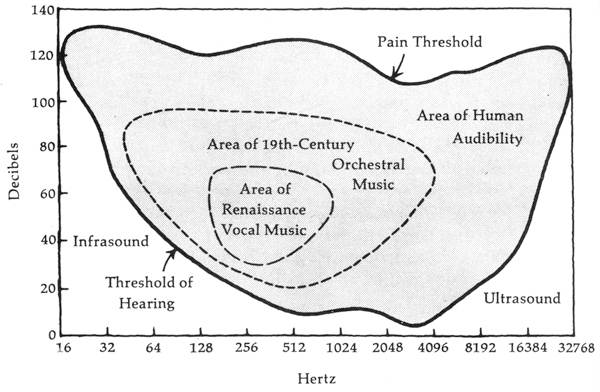The Soundscape

Hearing the world
The sound of modern life has a 60 hertz hum in the background because that’s the frequency of electricity (in North America). Add to that all the other vibrations of technological artifacts and all the sounds made by nature and you get the soundscape of the world. I learned to hear this sonic environment from this master observer. He gave me ears. Once heard these vibrations can be tuned, altered, muffled, amplified.
10/15/13Excerpt
The Flat Line in Sound
The Industrial Revolution introduced another effect into the soundscape: the flat line.
A few years ago, while listening to the stonemasons' hammers on the Takht-e-Jamshid in Teheran, I suddenly realized that in all earlier societies the majority of sounds were discrete and interrupted, while today a large portion -- perhaps the majority -- are continuous. This new sound phenomenon, introduced by the Industrial Revolution and greatly extended by the Electric Revolution, today subjects us to permanent keynotes and swaths of broad-band noise, possessing little personality or sense of progression.
*
*
The best way to comprehend what I mean by acoustic design is to regard the soundscape of the world as a huge musical composition, unfolding around us ceaselessly. We are simultaneously its audience, its performers and its composers. Which sounds do we want to preserve, encourage, multiply?
*
Another continuous rhythm is that of breathing, which also varies in tempo with exercise and relaxation. Normal breathing is said to vary between 12 and 20 cycles per minute, that is, 3 to 5 seconds per cycle. But breathing may be slowed down during relaxation or sleep to cycles lasting 6 to 8 seconds. Part of the sense of well-being we feel at the seashore undoubtedly has to do with the fact that the relaxed breathing pattern shows surprising correspondence with the rhythms of the breakers, which, while never regular, often produce an average cycle of 8 seconds.
*
Another biological tempo which relates significantly to the acoustic environment is that of the resolving power of the sense receptors. In humans this hovers around 16 to 20 cycles per second. It is in this frequency range that a series of discrete images or sounds will fuse together to give an impression of continuous flow. Film employs 24 frames per second in order to avoid flicker. As far as aural perception is concerned, a rapid rhythmic vibration will gradually assume an identifiable pitch at about 20 cycles per second. Thus, as the tempo of human activities increases, the rhythms of foot and hand are mechanized, first into the rough, "grainy" concatenation of the Industrial Revolution's first tools, and finally into the smooth pitch contours of modem electronics. The resolving power of the senses makes it possible to turn some of the nervous agitation of the soundscape into drones which, being less turbulent to the ears, tend to have a pacifying quality.
*
In Turkish cars, horns are tuned to the interval of a major or minor second. While in some cultures this is considered an exceedingly dissonant diad, there are examples in the Balkans, for instance from certain regions of western Bulgaria, of folk singing in which two voices sing together in major or minor seconds, the singers considering this a consonant interval.
The Soundscape R. Murray Schafer 1993, 320 pages $12







